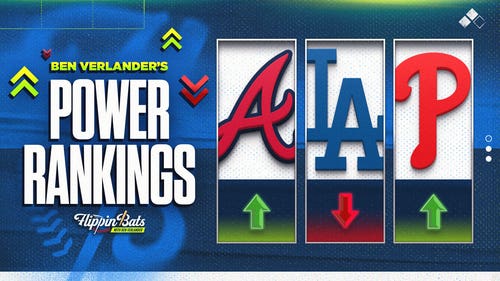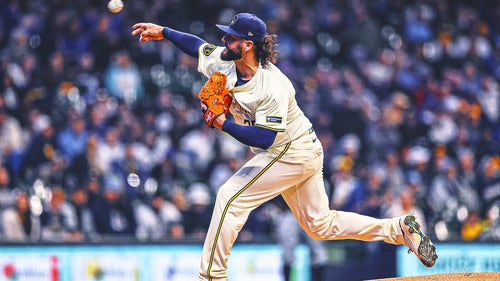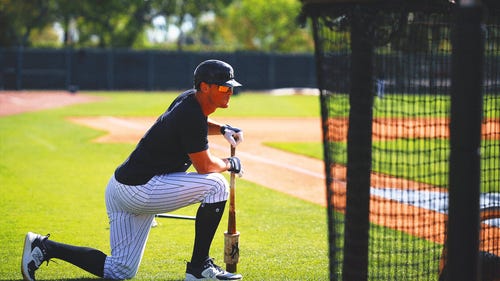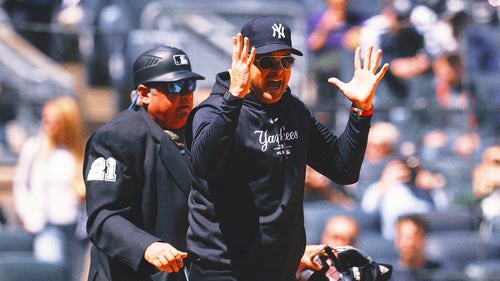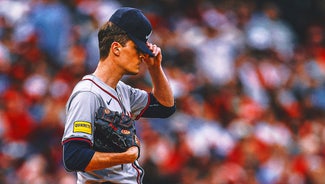
The Mariners transformed their bullpen, and Los Bomberos are thriving
By Jordan Shusterman
FOX Sports MLB Writer
Last month in Detroit, several members of the Mariners' bullpen went out to dinner. For right-hander Paul Sewald, it was familiar in one sense, as a group of Seattle relievers had gathered for dinner about 14 months earlier during the annual trip to the Motor City. But then Sewald realized something.
"I looked around," Sewald told FOX Sports. "And literally just Fleming Baez, the bullpen catcher, and I were the only two people that were there a year ago."
As has become rather normal in the Jerry Dipoto Era, the Mariners' roster has indeed turned over a fair bit over the past calendar year — and for the better.
The 2021 Mariners were something of a mirage. They won 90 games with a minus-51 run differential but an off-the-charts fun differential — thanks in large part to a 33-18 record in one-run games — which made for a wild season, albeit not one that felt particularly sustainable.
In turn, Dipoto made significant upgrades to the roster this past winter and again at the trade deadline, and those have put the Mariners in excellent position to finally end their two-decade-plus postseason drought.
But the evolution — and transformation — of the bullpen in particular merits a closer look. A big part of the team’s success in close contests a year ago was predicated on a bullpen that consistently delivered when called upon. While it was hardly brimming with household names, it was chock-full of hidden gems such as Sewald, Drew Steckenrider and Casey Sadler, who consistently slammed the door when their names were called. Rafael Montero, Anthony Misiewicz, Will Vest, JT Chargois and Keynan Middleton each made 30-plus appearances. Kendall Graveman was downright dominant until his trade to Houston.
As Sewald observed, for a variety of reasons, from trades to injuries to poor performance, none of those guys are still around. And yet: "We were a top-five bullpen in the league last year. And now we are a top-five bullpen in the league again with totally different guys," Sewald said. "When you think about it like that, we've just replaced really great pitchers from last year with better pitchers this year. It's been really fun to watch."
This year, the Seattle bullpen has a bunch of new faces and, perhaps more importantly, a new nickname: Los Bomberos, the Firemen.
Sewald might lead the team in saves with 19, but Andres Muñoz — the one who introduced the Bomberos bullpen nickname — has been the clear headliner. The 23-year-old right-hander was acquired from San Diego as part of the Austin Nola haul back at the 2020 deadline. He showcased his electric heater in 23 innings with the Padres as a 20-year-old in 2019 but required Tommy John surgery in spring training the following year, which took him off the radar for a while.
Now fully back from TJ, Muñoz has picked up right where he left off with one of the most dynamic fastball-slider combos in baseball — one that is strikingly similar to that of former Mariners closer Edwin Diaz. Manager Scott Servais has deployed him in any semblance of high-leverage situation, no matter the inning, and Muñoz has delivered time and time again. He’s currently ninth among all relievers in fWAR and has a 39.3% strikeout rate that ranks behind only, fittingly, the aforementioned Diaz.
It’s tough to match Muñoz’s high-octane arsenal, but this bullpen has no shortage of pure stuff. Erik Swanson’s splitter. Diego Castillo’s sinker. Matt Festa’s slider. And arguably the crown jewel of them all, rookie Matt Brash's ridiculous breaking ball.
Brash, a starter in High-A when Sewald was out to dinner in Detroit last year, has burst onto the scene in 2022, especially since moving to the bullpen full-time. He, too, throws hard, but it’s his slider, which features more horizontal movement than any other in baseball, that has his teammates’ — and Pitching Ninja’s — attention:
"A 90 mph slider with 20 inches of horizontal movement is rather unfair," reliever Penn Murfee said of his teammate’s standout pitch.
"It’s insane," Festa agreed. "What are you supposed to do with that?"
Brash began the year in the Seattle rotation but struggled with strike-throwing enough to prompt a demotion and eventual transition to a relief role that has worked wonders. After posting a 7.65 ERA in 20 innings as a starter, the 24-year-old has put up a 1.50 ERA in 24 relief innings, including 12 consecutive scoreless outings dating to Aug. 17.
Brash’s integration also flowed seamlessly into a bullpen that was slowly finding its stride as the summer went on — just like the rest of the roster.
While the dramatic brawl with the Angels on June 26 is often cited as the turning point of this Mariners season, the turnaround really began the week prior. After falling to 29-39 on June 19, Seattle rattled off a five-game winning streak before losing the game in which the brawl occurred. A few days later, a new streak began — a 14-game heater that carried Seattle all the way to the All-Star break.
In June, Seattle’s odds to end the historic playoff drought fell as low as 5%. Now, with just a few weeks to play, FanGraphs forecasts the drought as having a 99% chance of being broken. Since June 21, the Mariners have gone 51-23, roughly a 112-win pace over 162 games and the second-best record in MLB behind only the Dodgers (58-19).
Here’s how their relief corps stacks up across the league since then:
3.5 fWAR (third)
2.48 ERA (first)
3.28 FIP (second)
27.2% strikeout rate (second)
80% strand rate (first)
.188 BAA (first)
1.03 WHIP (second)
For as good as the 2021 unit was, Los Bomberos have set a new standard. And while this year’s group arguably outranks last year’s on pure talent, they have also benefited immensely from something the 2021 team clearly lacked: elite starting pitching.
Mariners starting pitchers have posted a 3.35 ERA since June 21, fourth-lowest in baseball, and have been particularly incredible of late.
Having such a reliable starting rotation does more than just help teams win baseball games — it also allows the relievers to relax and enjoy each other’s company for the first part of the game without worrying about coming in earlier than planned.
"The fact that we don't have bullpen days twice a week makes it a lot easier for us," Sewald said. "There's not a lot of panic down there. We feel like we have four innings to really hang out and mess around and talk."
"Everyone's real chatty for, like, four innings," Festa added. "I can't keep my mouth shut, so I'm always talking. Me and Swanny have a lot of fun."
Eventually, the relaxation and conversation turn to focus and preparation.
"We're so comfortable with whatever situation is thrown at us," Festa said.
"Our bullpen coach [Trent Blank] does a really good job," Murfee said. "If there's a situation where he feels like he needs to inform us of something that could come up during the game, he's very good about giving us a heads-up. We've just gotten in a pretty good rhythm of understanding when certain names are gonna be called."
It’s fitting that Murfee referenced Blank, a key member of the Mariners’ pitching development group since joining the organization in 2019.
"It doesn’t matter if it’s with our first-rounder or our 30th-rounder. We really believe we can make everyone better," Blank said after being promoted to bullpen coach and Director of Pitching Strategy for the 2021 season.
Building a bullpen is never just about acquiring the guys who throw the hardest or have the nastiest stuff. It’s also about finding players who can simply get outs, the way Murfee — a former 33rd-round pick who didn’t start pitching full-time until his senior year of college — has demonstrated in his breakout rookie campaign. The 28-year-old has posted a 2.68 ERA in 58.1 innings with a 0.91 WHIP that ranks 12th-lowest among all qualified relievers, with two of the 11 lower belonging to Sewald (0.77) and Swanson (0.88).
"It's sexy to throw hard. And don't get me wrong, I wish like hell I could throw 95-100," said Murfee, whose fastball averages about 89 mph but whose ability to suppress hard contact is among the best in the league. "I think it's just about creating unique looks and, more than anything, keeping guys off-balance. You can do that with 90."
Sewald echoed this sentiment: "As we've seen, [velocity] is not the only thing that matters. It gets you away with some mistakes, but depending on the angle, I can throw pitches right down the middle at 91 and be just as effective as somebody who throws 96 down the middle."
Murfee and Sewald have both thrived as Mariners by relying on unusual release points to compensate for relatively below-average velocity for a late-inning reliever.
"Unique is the most important thing," Sewald said. "Penn and I have very unique, step across our bodies, throw from a low angle, throw the ball up [deliveries] … but it’s funny, he has cut-ride, I have run-ride. Our pitch characteristics are totally different even though our deliveries are very similar. If you told a 2004 pitching coach that the two of us were on the same team, they would think you have the same two pitchers. Why would you want those two together?"
Since it’s not 2004, the Mariners have found a way to maximize both of these same-but-different deliveries in the same bullpen, even if they aren’t throwing a billion miles an hour.
That’s not to say Sewald can’t appreciate how hard big-league pitchers throw nowadays. "That game we played against the Yankees when [Luis] Castillo pitched against Gerrit Cole. Me, [Scott] Effross and [Matt] Festa were the only three pitchers that threw a fastball under 95. In a 13-inning game! The evolution of velocity is crazy."
Indeed, the numbers from that August classic are staggering. Nine pitchers combined to throw 202 of the 367 total pitches in the game above 95 mph, with only Sewald (94.7), Festa (94.0) and the side-armer Effross (91.9) maxing out below that threshold.
Beyond the historic display of velocity, that game was one of Seattle’s signature wins of the season – a profound demonstration that they could hang with a powerhouse team such as the Yankees in an epic battle for 13 innings.
The clear goal for the Mariners entering 2022 was simple: end the drought. Two-plus decades without postseason baseball is a long time.
The Mariners are a solid offensive team, led by a generational talent in Julio Rodriguez and just enough other impact bats in All-Star Ty France and home run machine Eugenio Suarez to make opposing pitchers sweat.
On the mound, however, Seattle boasts an incredibly deep group of pitchers that matches up with nearly any across the league. It is this group that has all but ensured the Mariners will finally play postseason baseball games again.
Better yet, it is that group that gives the Mariners the best chance to win postseason baseball games again.
Jordan Shusterman is half of @CespedesBBQ and a baseball writer for FOX Sports. Follow him on Twitter @j_shusterman_.






































































































































